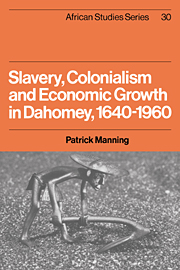Book contents
- Frontmatter
- Contents
- Maps
- Tables
- Figures
- Preface
- 1 Slavery, colonialism and economic growth, 1640–1960
- 2 The Dahomean economy, 1640–1890
- 3 Struggles with the gods: economic life in the 1880s
- 4 Production, 1890–1914
- 5 Demand, 1890–1914
- 6 Exchange, 1890–1914
- 7 The alien state, 1890–1914
- 8 Social struggles for economic ends, 1890–1914
- 9 The mechanism of accumulation
- 10 Capitalism and colonialism, 1915–60
- 11 The Dahomean national movement
- 12 Epilogue
- Notes
- Appendix 1 Export revenue from Dahomey, 1640s–1950s
- Appendix 2 Slave exports by ethnic origin
- Appendix 3 Population loss due to slave exports
- Appendix 4 Foreign trade of Dahomey
- Appendix 5 Foreign trade indices
- Appendix 6 Rainfall
- Appendix 7 Fiscal flows
- Appendix 8 Money supply of colonial Dahomey
- Bibliography
- Index
Appendix 7 - Fiscal flows
Published online by Cambridge University Press: 26 October 2009
- Frontmatter
- Contents
- Maps
- Tables
- Figures
- Preface
- 1 Slavery, colonialism and economic growth, 1640–1960
- 2 The Dahomean economy, 1640–1890
- 3 Struggles with the gods: economic life in the 1880s
- 4 Production, 1890–1914
- 5 Demand, 1890–1914
- 6 Exchange, 1890–1914
- 7 The alien state, 1890–1914
- 8 Social struggles for economic ends, 1890–1914
- 9 The mechanism of accumulation
- 10 Capitalism and colonialism, 1915–60
- 11 The Dahomean national movement
- 12 Epilogue
- Notes
- Appendix 1 Export revenue from Dahomey, 1640s–1950s
- Appendix 2 Slave exports by ethnic origin
- Appendix 3 Population loss due to slave exports
- Appendix 4 Foreign trade of Dahomey
- Appendix 5 Foreign trade indices
- Appendix 6 Rainfall
- Appendix 7 Fiscal flows
- Appendix 8 Money supply of colonial Dahomey
- Bibliography
- Index
Summary
Dahomey and AOF each published budgets for every fiscal year. The relevant documents for this analysis, however, are the financial reports: Afrique Occidentale Francaise, Direction des Finances et de la Comptabilité, Compte definitifdes recettes et des dépenses du budget général; Colonie du Dahomey, Compte définitif des recettes et des dépenses du budget local du Dahomey. At the beginning and the end of the colonial period when these were unavailable or inadequate, figures were drawn from Colonie du Dahomey, Rapport d'Ensemble; Afrique Occidentale Francaise, Gouvernement General, Annuaire statistique de L'AOF, and République du Dahomey, Bulletin du statistique. Comparison of all available documents helps to compensate for insufficient reporting on flows of funds between AOF and Dahomey. The format of financial reports changed frequently, making time-series comparisons difficult, especially for expenditures, Successive deposits and withdrawals from reserves artificially inflated reported budget totals; I have reduced published totals to show net movements of reserves only.
Catherine Coquery-Vidrovitch generously made available to me the figures on public finance in Dahomey and AOF compiled as part of a broad and important study which is being completed under her leadership: Recherche Coopérative du Programme 326, CNRS, ‘Commerce, investissements et profits dans l'Outre-mer français’. These figures confirm those shown in Tables A7.1 and A7.2, except for small differences. For instance, I included railroads as part of the revenues and expenditures of Dahomey, 1920–34, while Coquery-Vidrovitch's group left them out.
For the era of price stability up to 1914,1 included estimates of the payments of AOF salaries in Dahomey and of salary remittances from Dahomey to France; the latter was larger than the former.
- Type
- Chapter
- Information
- Slavery, Colonialism and Economic Growth in Dahomey, 1640–1960 , pp. 404 - 410Publisher: Cambridge University PressPrint publication year: 1982

